中秋节英文版介绍
- 格式:pdf
- 大小:205.59 KB
- 文档页数:5
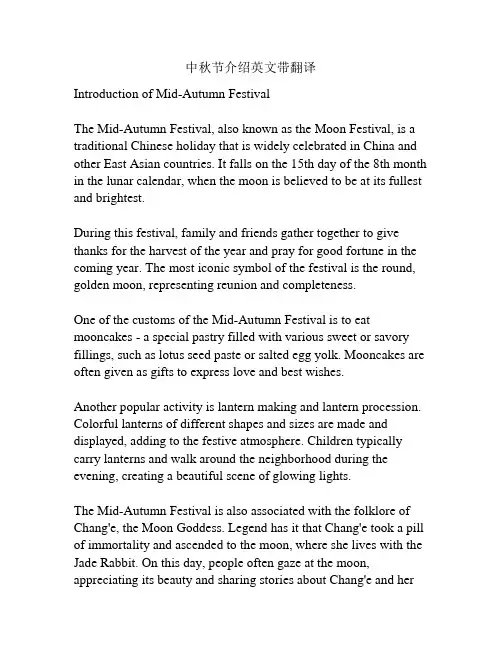
中秋节介绍英文带翻译Introduction of Mid-Autumn FestivalThe Mid-Autumn Festival, also known as the Moon Festival, is a traditional Chinese holiday that is widely celebrated in China and other East Asian countries. It falls on the 15th day of the 8th month in the lunar calendar, when the moon is believed to be at its fullest and brightest.During this festival, family and friends gather together to give thanks for the harvest of the year and pray for good fortune in the coming year. The most iconic symbol of the festival is the round, golden moon, representing reunion and completeness.One of the customs of the Mid-Autumn Festival is to eat mooncakes - a special pastry filled with various sweet or savory fillings, such as lotus seed paste or salted egg yolk. Mooncakes are often given as gifts to express love and best wishes.Another popular activity is lantern making and lantern procession. Colorful lanterns of different shapes and sizes are made and displayed, adding to the festive atmosphere. Children typically carry lanterns and walk around the neighborhood during the evening, creating a beautiful scene of glowing lights.The Mid-Autumn Festival is also associated with the folklore of Chang'e, the Moon Goddess. Legend has it that Chang'e took a pill of immortality and ascended to the moon, where she lives with the Jade Rabbit. On this day, people often gaze at the moon, appreciating its beauty and sharing stories about Chang'e and hermyth.Overall, the Mid-Autumn Festival is a time for family reunion, expressing gratitude, and enjoying the abundance of nature. It is a cherished tradition that brings people together and spreads joy and warmth.中秋节介绍中秋节,亦被称为月亮节,是中国以及其他东亚国家广泛庆祝的传统节日。
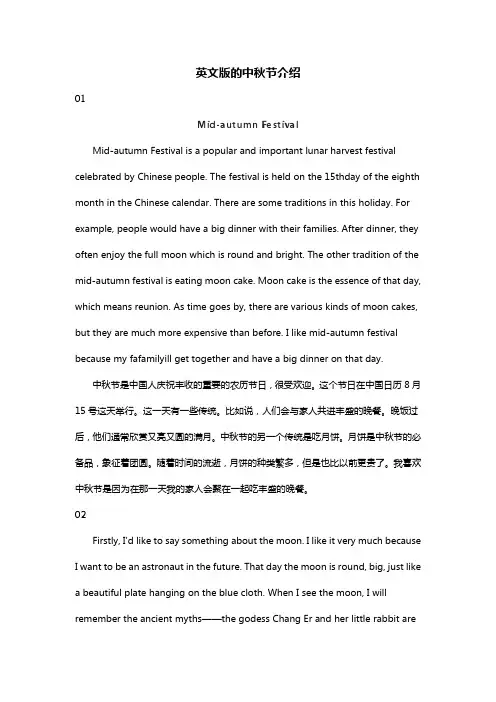
英文版的中秋节介绍01Mid-autumn FestivalMid-autumn Festival is a popular and important lunar harvest festival celebrated by Chinese people. The festival is held on the 15thday of the eighth month in the Chinese calendar. There are some traditions in this holiday. For example, people would have a big dinner with their families. After dinner, they often enjoy the full moon which is round and bright. The other tradition of the mid-autumn festival is eating moon cake. Moon cake is the essence of that day, which means reunion. As time goes by, there are various kinds of moon cakes, but they are much more expensive than before. I like mid-autumn festival because my fafamilyill get together and have a big dinner on that day.中秋节是中国人庆祝丰收的重要的农历节日,很受欢迎。
这个节日在中国日历8月15号这天举行。
这一天有一些传统。
比如说,人们会与家人共进丰盛的晚餐。
晚饭过后,他们通常欣赏又亮又圆的满月。
中秋节的另一个传统是吃月饼。
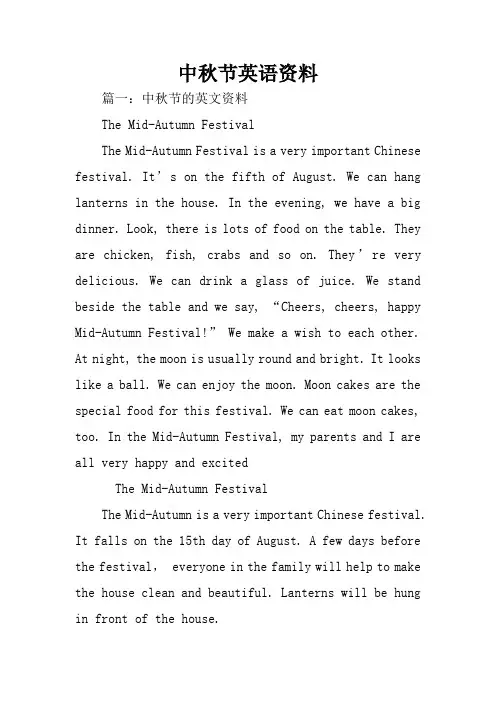
中秋节英语资料篇一:中秋节的英文资料The Mid-Autumn FestivalThe Mid-Autumn Festival is a very important Chinese festival. It’s on the fifth of August. We can hang lanterns in the house. In the evening, we have a big dinner. Look, there is lots of food on the table. They are chicken, fish, crabs and so on. They’re very delicious. We can drink a glass of juice. We stand beside the table and we say, “Cheers, cheers, happy Mid-Autumn Festival!” We make a wish to each other. At night, the moon is usually round and bright. It looks like a ball. We can enjoy the moon. Moon cakes are the special food for this festival. We can eat moon cakes, too. In the Mid-Autumn Festival, my parents and I are all very happy and excitedThe Mid-Autumn FestivalThe Mid-Autumn is a very important Chinese festival. It falls on the 15th day of August. A few days before the festival, everyone in the family will help to make the house clean and beautiful. Lanterns will be hung in front of the house.On the evening there will be a big family dinner. People who work far away from their homes will try to come back for the union. After dinner, people will light the lanterns which are usually red and round. Children will play with their own toy lanterns happily.At night the moon is usually round and bright. People can enjoy the moon while eating moon-cakes which are the special food for this festival. They can look back on the past and look forward to the future ’Day Teachers' Day comes on September 10th every year. On the day we usually give our teachers cards to show our thanks. I thank them for helping me when I am in trouble, and I thank them for teaching me how to be a real man.Of course they are very friendly to everyone. They always get on very well with their students. They are not only our teachers but also our friends. They love us very much and we love them,too.英语笑话 A Good BoyLittle Robert asked his mother for two cents. "What did you do with the money I gave you yesterday" "I gave it to a poor old woman," he answered. "You're a goodboy," said the mother proudly. "Here are two cents more. But why are you so interested in the old woman" "She is the one who sells the candy."好孩子小罗伯特向妈妈要两分钱。
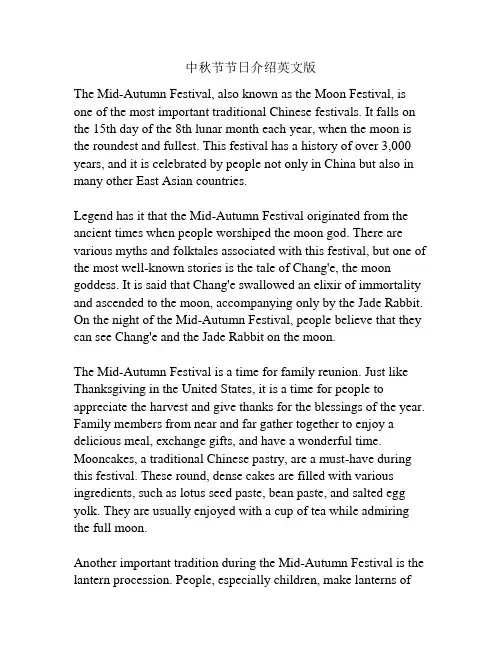
中秋节节日介绍英文版The Mid-Autumn Festival, also known as the Moon Festival, is one of the most important traditional Chinese festivals. It falls on the 15th day of the 8th lunar month each year, when the moon is the roundest and fullest. This festival has a history of over 3,000 years, and it is celebrated by people not only in China but also in many other East Asian countries.Legend has it that the Mid-Autumn Festival originated from the ancient times when people worshiped the moon god. There are various myths and folktales associated with this festival, but one of the most well-known stories is the tale of Chang'e, the moon goddess. It is said that Chang'e swallowed an elixir of immortality and ascended to the moon, accompanying only by the Jade Rabbit. On the night of the Mid-Autumn Festival, people believe that they can see Chang'e and the Jade Rabbit on the moon.The Mid-Autumn Festival is a time for family reunion. Just like Thanksgiving in the United States, it is a time for people to appreciate the harvest and give thanks for the blessings of the year. Family members from near and far gather together to enjoy a delicious meal, exchange gifts, and have a wonderful time. Mooncakes, a traditional Chinese pastry, are a must-have during this festival. These round, dense cakes are filled with various ingredients, such as lotus seed paste, bean paste, and salted egg yolk. They are usually enjoyed with a cup of tea while admiring the full moon.Another important tradition during the Mid-Autumn Festival is the lantern procession. People, especially children, make lanterns ofdifferent shapes and sizes, using materials such as paper, silk, and bamboo. They carry these lanterns and walk around the neighborhood, creating a colorful display of lights. Lantern riddles are also popular during this time. Riddles are written on pieces of paper and attached to the lanterns. People can try to solve the riddles to win small prizes or simply enjoy the challenge.Throughout the Mid-Autumn Festival, many cultural activities are organized to celebrate this joyous occasion. Traditional performances, such as dragon and lion dances, are held, attracting both locals and tourists. Cultural exhibitions featuring traditional crafts, calligraphy displays, and storytelling sessions are also common. These activities provide an opportunity for people to learn more about the rich Chinese culture and heritage.In recent years, the Mid-Autumn Festival has become more than just a traditional celebration. It has evolved into a time for people to express their love and care for one another. Many young people who are unable to return home for the festival send mooncakes and gifts to their families and friends as a gesture of love and appreciation. It has also become a popular time for companies and organizations to hold events and gatherings to strengthen relationships among employees and partners.In conclusion, the Mid-Autumn Festival is a significant celebration in Chinese culture. It represents family reunion, gratitude, and the appreciation of the moon's beauty. Whether it is enjoying a delicious mooncake, admiring lanterns, or participating in cultural activities, the festival brings joy and warmth to people's lives. Itserves as a reminder that no matter where we are, the moon will always be there, shining brightly and connecting us all.。

中秋节(Mid-Autumn Festival)通常在每年农历八月十五举行,这个节日有着丰富的活动、象征和精神意义。
以下是有关中秋节的介绍,包括时间、活动、象征和精神的句子:时间(Time):中秋节通常在农历八月十五,也就是每年的秋分之后的满月日子。
This traditional festival falls on the 15th day of the eighth lunar month, which is always after the autumn equinox.活动(Activities):中秋节的庆祝活动包括家庭聚餐,赏月,吃月饼,和赠送中秋礼品。
The festivities of the Mid-Autumn Festival include family gatherings, moon viewing, enjoying mooncakes, and exchanging Mid-Autumn gifts.象征(Symbols):月亮是中秋节的主要象征,它代表团圆和圆满。
The moon is the primary symbol of the Mid-Autumn Festival, representing reunion and completeness.月饼也是中秋节的象征,它代表着团圆之意。
Mooncakes are another symbol of the Mid-Autumn Festival, symbolizing reunion.精神(Spirit):中秋节强调家庭团聚,感恩和思念远方的亲人。
The spirit of the Mid-Autumn Festival emphasizes family reunions, gratitude, and missing loved ones who may be far away.这个节日也传承了中国的传统价值观,如孝顺和亲情。
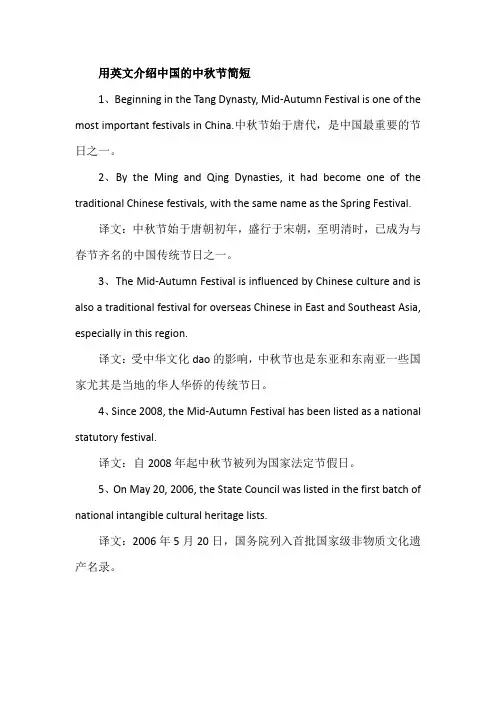
用英文介绍中国的中秋节简短1、Beginning in the Tang Dynasty, Mid-Autumn Festival is one of the most important festivals in China.中秋节始于唐代,是中国最重要的节日之一。
2、By the Ming and Qing Dynasties, it had become one of the traditional Chinese festivals, with the same name as the Spring Festival.译文:中秋节始于唐朝初年,盛行于宋朝,至明清时,已成为与春节齐名的中国传统节日之一。
3、The Mid-Autumn Festival is influenced by Chinese culture and is also a traditional festival for overseas Chinese in East and Southeast Asia, especially in this region.译文:受中华文化dao的影响,中秋节也是东亚和东南亚一些国家尤其是当地的华人华侨的传统节日。
4、Since 2008, the Mid-Autumn Festival has been listed as a national statutory festival.译文:自2008年起中秋节被列为国家法定节假日。
5、On May 20, 2006, the State Council was listed in the first batch of national intangible cultural heritage lists.译文:2006年5月20日,国务院列入首批国家级非物质文化遗产名录。
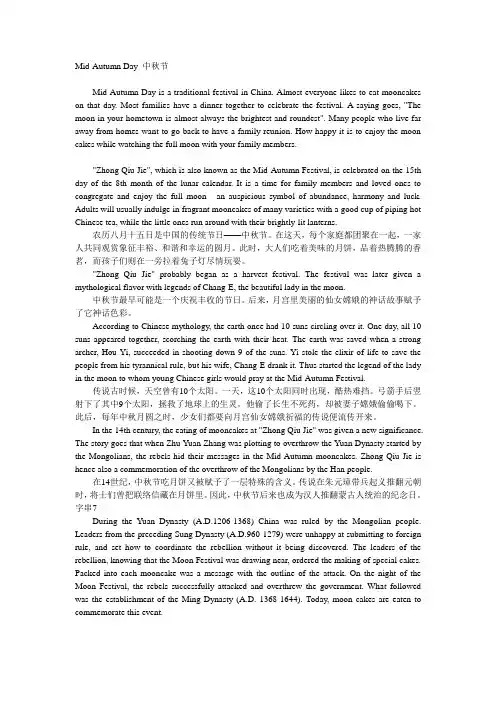
Mid-Autumn Day 中秋节Mid-Autumn Day is a traditional festival in China. Almost everyone likes to eat mooncakes on that day. Most families have a dinner together to celebrate the festival. A saying goes, "The moon in your hometown is almost always the brightest and roundest". Many people who live far away from homes want to go back to have a family reunion. How happy it is to enjoy the moon cakes while watching the full moon with your family members."Zhong Qiu Jie", which is also known as the Mid-Autumn Festival, is celebrated on the 15th day of the 8th month of the lunar calendar. It is a time for family members and loved ones to congregate and enjoy the full moon - an auspicious symbol of abundance, harmony and luck. Adults will usually indulge in fragrant mooncakes of many varieties with a good cup of piping hot Chinese tea, while the little ones run around with their brightly-lit lanterns.农历八月十五日是中国的传统节日——中秋节。
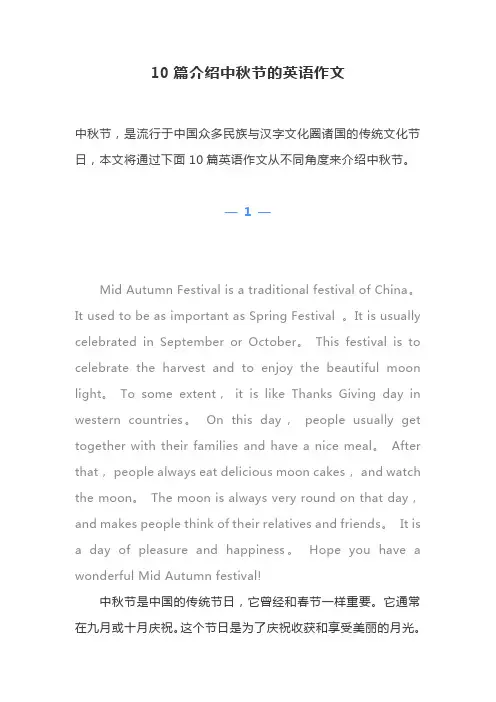
10篇介绍中秋节的英语作文中秋节,是流行于中国众多民族与汉字文化圈诸国的传统文化节日,本文将通过下面10篇英语作文从不同角度来介绍中秋节。
—1 —Mid Autumn Festival is a traditional festival of China。
It used to be as important as Spring Festival 。
It is usually celebrated in September or October。
This festival is to celebrate the harvest and to enjoy the beautiful moon light。
To some extent,it is like Thanks Giving day in western countries。
On this day,people usually get together with their families and have a nice meal。
After that,people always eat delicious moon cakes,and watch the moon。
The moon is always very round on that day,and makes people think of their relatives and friends。
It is a day of pleasure and happiness。
Hope you have a wonderful Mid Autumn festival!中秋节是中国的传统节日,它曾经和春节一样重要。
它通常在九月或十月庆祝。
这个节日是为了庆祝收获和享受美丽的月光。
在某种程度上,它是比如感谢在西方国家度过一天。
在这一天,人们通常会和家人在一起吃饭。
在那之后,人们总是吃美味的月饼,看月亮。

关于中秋节介绍的英文NO.1The Mid-Autumn Festival is one of the traditional Chinese festivals, also known as the "Full Moon Festival". On this day, family members gather together to eat moon cakes, enjoy the moon and express the meaning of reunion. Moon cakes are the traditional food of the Mid-Autumn Festival, which symbolizes reunion and harmony. Mooncakes are usually round and filled with various fillings, which are rich and delicious. Besides eating moon cakes, appreciating the moon on the night of the Mid-Autumn Festival is also one of the important customs. The ancients believed that the moon represented yin and motherhood, so the tradition of worshipping the moon has been handed down to this day. The Mid-Autumn Festival is a time for family reunion, as well as a time to celebrate the harvest and pray for happiness.中秋节是中国传统节日之一,也有称其为“月圆节”。
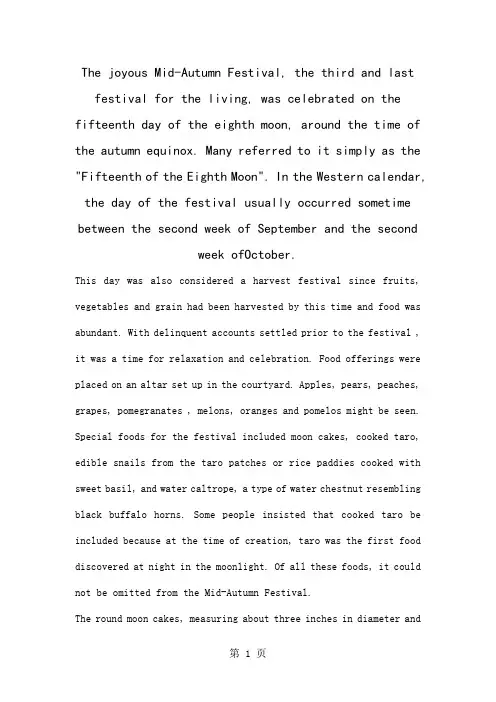
The joyous Mid-Autumn Festival, the third and last festival for the living, was celebrated on the fifteenth day of the eighth moon, around the time of the autumn equinox. Many referred to it simply as the "Fifteenth of the Eighth Moon". In the Western calendar, the day of the festival usually occurred sometime between the second week of September and the secondweek ofOctober.This day was also considered a harvest festival since fruits, vegetables and grain had been harvested by this time and food was abundant. With delinquent accounts settled prior to the festival , it was a time for relaxation and celebration. Food offerings were placed on an altar set up in the courtyard. Apples, pears, peaches, grapes, pomegranates , melons, oranges and pomelos might be seen. Special foods for the festival included moon cakes, cooked taro, edible snails from the taro patches or rice paddies cooked with sweet basil, and water caltrope, a type of water chestnut resembling black buffalo horns. Some people insisted that cooked taro be included because at the time of creation, taro was the first food discovered at night in the moonlight. Of all these foods, it could not be omitted from the Mid-Autumn Festival.The round moon cakes, measuring about three inches in diameter andone and a half inches in thickness, resembled Western fruitcakes in taste and consistency. These cakes were made with melon seeds, lotus seeds, almonds, minced meats, bean paste, orange peels and lard. A golden yolk from a salted duck egg was placed at the center of each cake, and the golden brown crust was decorated with symbols of the festival. Traditionally, thirteen moon cakes were piled in a pyramid to symbolize the thirteen moons of a "complete year," that is, twelve moons plus one intercalary moon.OriginThe Mid-Autumn Festival is a traditional festivity for both the Han and minority nationalities. The custom of worshipping the moon (called xi yue in Chinese) can be traced back as far as the ancient Xia and Shang Dynasties (2000 B.C.-1066 B.C.). In the Zhou Dynasty(1066 B.C.-221 B.C.), people hold ceremonies to greet winter and worship the moon whenever the Mid-Autumn Festival sets in. It becomes very prevalent in the Tang Dynasty(618-907 A.D.) that people enjoy and worship the full moon. In the Southern Song Dynasty (1127-1279 A.D.), however, people send round moon cakes to their relatives as gifts in expression of their best wishes of family reunion. When it becomes dark, they look up at the full silver moon or go sightseeing on lakes to celebrate the festival. Since the Ming (1368-1644 A.D. ) and Qing Dynasties (1644-1911A.D.), thecustom of Mid-Autumn Festival celebration becomes unprecedented popular. Together with the celebration there appear some special customs in different parts of the country, such as burning incense, planting Mid-Autumn trees, lighting lanterns on towers and fire dragon dances. However, the custom of playing under the moon is not so popular as it used to be nowadays, but it is not less popular to enjoy the bright silver moon. Whenever the festival sets in, people will look up at the full silver moon, drinking wine to celebrate their happy life or thinking of their relatives and friends far from home, and extending all of their best wishes to them.Moon CakesThere is this story about the moon-cake. during the Yuan dynasty (A.D. 1280-1368) China was ruled by the Mongolian people. Leaders from the preceding Sung dynasty (A.D. 960-1280) were unhappy at submitting to the foreign rule, and set how to coordinate the rebellion without being discovered. The leaders of the rebellion, knowing that the Moon Festival was drawing near, ordered the making of special cakes. Backed into each moon caked was a message with the outline of the attack. On the night of the Moon Festival, the rebels successfully attached and overthrew the government. Today, moon cakes are eaten to commemorate this legend and was called theMoon Cake.For generations, moon cakes have been made with sweet fillings of nuts, mashed red beans, lotus-seed paste or Chinese dates, wrapped in a pastry. Sometimes a cooked egg yolk can be found in the middle of the rich tasting dessert. People compare moon cakes to the plum pudding and fruit cakes which are served in the English holiday seasons.Nowadays, there are hundreds varieties of moon cakes on sale a month before the arrival of Moon Festival.Different Celebrated FormsFor thousands of years, the Chinese people have related the vicissitudes of life to changes of the moon as it waxes and wanes; joy and sorrow, parting and reunion. Because the full moon is round and symbolizes reunion, the Mid-Autumn Festival is also known as the festival of reunion. All family members try to get together on this special day. Those who can not return home watch the bright moonlight and feel deep longing for their loved ones.Today,festivities centered about the Mid-Autumn Festival are more varied. After a family reunion dinner, many people like to go out to attend special perfomances in parks or on public squares. People in different parts of China have different ways to celebrate the Mid-Autumn Festival. In Guangzhou in South China, a huge lanternshow is a big attraction for local citizens. Thousands of differently shaped lanterns are lit, forming a fantastic contrast with the bright moonlight.In East Chia's Zhejiang Province, watching the flood tide of the Qian-tang River during the Mid-Autumn Festival is not only a must for local peple, but also an attraction for those from other parts of the country. The ebb and flow of tides coincide with the waxing and waning of the moon as it exerts a strong gravitational pull. In mid autumn, the sun, earth and moon send out strong gravitational forces upon the seas. The outh of the Qiantang River is shaped lik a bugle. So the flood tide which forms at the narrow mouth is particularly impressive. Spectators crowd on the river bank,watching the roaring waves. At its peak, the tide rises as high as three and a half meters.希望以上资料对你有所帮助,附励志名言3条:1、有志者自有千计万计,无志者只感千难万难。
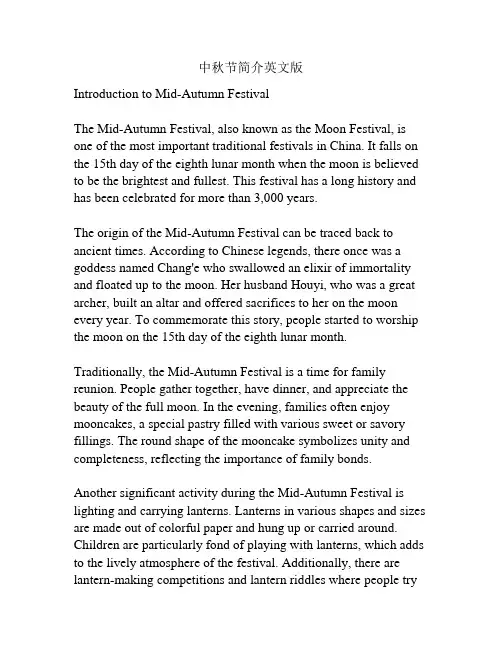
中秋节简介英文版Introduction to Mid-Autumn FestivalThe Mid-Autumn Festival, also known as the Moon Festival, is one of the most important traditional festivals in China. It falls on the 15th day of the eighth lunar month when the moon is believed to be the brightest and fullest. This festival has a long history and has been celebrated for more than 3,000 years.The origin of the Mid-Autumn Festival can be traced back to ancient times. According to Chinese legends, there once was a goddess named Chang'e who swallowed an elixir of immortality and floated up to the moon. Her husband Houyi, who was a great archer, built an altar and offered sacrifices to her on the moon every year. To commemorate this story, people started to worship the moon on the 15th day of the eighth lunar month.Traditionally, the Mid-Autumn Festival is a time for family reunion. People gather together, have dinner, and appreciate the beauty of the full moon. In the evening, families often enjoy mooncakes, a special pastry filled with various sweet or savory fillings. The round shape of the mooncake symbolizes unity and completeness, reflecting the importance of family bonds.Another significant activity during the Mid-Autumn Festival is lighting and carrying lanterns. Lanterns in various shapes and sizes are made out of colorful paper and hung up or carried around. Children are particularly fond of playing with lanterns, which adds to the lively atmosphere of the festival. Additionally, there are lantern-making competitions and lantern riddles where people tryto solve puzzles written on lanterns.In recent years, the Mid-Autumn Festival has become more than just a traditional festival. It has gained popularity among people of different cultural backgrounds, and the celebrations have been extended to different parts of the world. Many countries with a significant Chinese population or cultural influence also celebrate the Moon Festival in their own unique ways.One of the most iconic elements of the Mid-Autumn Festival is the moon itself. People believe that on this night, the moon is at its brightest and roundest, symbolizing reunion and completeness. The full moon represents harmony and unity, which is a core value of Chinese culture.In conclusion, the Mid-Autumn Festival is a significant traditional Chinese festival celebrated on the 15th day of the eighth lunar month. It is a time for family reunion, appreciating the full moon, enjoying mooncakes, and lighting lanterns. The festival has a rich history and has become a popular cultural event worldwide, promoting unity and the importance of family bonds.。
中秋节简介纯英文版The Mid-Autumn Festival, also known as the Moon Festival, is a traditional Chinese holiday that is celebrated on the 15th day of the eighth lunar month. It is one of the most important festivals in Chinese culture and is celebrated by Chinese communities all around the world.During the Mid-Autumn Festival, family members come together to have a reunion dinner and express their gratitude for the harvest. The festival is also associated with the full moon, which symbolizes unity and completeness. It is believed that the moon is at its brightest and roundest on this day.One of the main customs of the Mid-Autumn Festival is the eating of mooncakes, a round pastry filled with various sweet or savory fillings. Mooncakes are often shared among family members and friends as a symbol of reunion and good luck.Another traditional activity during the festival is appreciating the moon. People gather in parks, open spaces, or on rooftops to admire the full moon and enjoy the moonlit night. Some even organize lantern procession, where children carry and display beautifully crafted lanterns.Furthermore, the Mid-Autumn Festival is also a time for storytelling and folklore. Chinese legends and myths related to the moon are often told during this time, such as the story of Chang'e, the moon goddess, and Wu Gang, the woodsman. These tales reflect the cultural significance and symbolism associated with the festival.In modern times, the Mid-Autumn Festival has evolved to include various cultural activities and events. These may include lantern-making competitions, traditional performances, and even modern interpretive events. It is a time for people to come together, appreciate their heritage, and celebrate the beauty and bounty of nature.Overall, the Mid-Autumn Festival is a cherished holiday that holds deep cultural significance for Chinese people. It is a time to honor family, express gratitude, and enjoy the beauty of the moon while indulging in delicious mooncakes.。
中秋节英文介绍带翻译简单版The Mid-Autumn Festival, also known as the Moon Festival, is a traditional Chinese festival that is celebrated on the 15th day of the 8th month of the lunar calendar. This year, it falls on October 1st. It is one of the most important holidays in Chinese culture and is also celebrated in many other Asian countries.The festival is a time for family and friends to gather and give thanks for the harvest and to pray for good fortune in the coming year. It is believed that on this day, the moon is at its brightest and roundest, symbolizing family reunion and happiness. People celebrate the festival by enjoying mooncakes, a special pastry filled with sweet or savory fillings, and by admiring the beautiful full moon.One of the most significant traditions of the Mid-Autumn Festival is the giving and sharing of mooncakes. Mooncakes are round pastries with various fillings such as lotus seed paste, red bean paste, or salted egg yolks. They are often intricately decorated with Chinese characters or images of the moon. Mooncakes are given as gifts to family, friends, and business partners as a symbol of good luck and blessings.Another popular custom during the festival is the lion dance. The lion dance is a traditional performance where dancers dress up as lions and perform acrobatic movements to the beat of drums and cymbals. It is believed to bring good luck and drive away evil spirits.On the night of the Mid-Autumn Festival, people gather together toappreciate the beauty of the moon. Many parks and public spaces set up lantern exhibitions where people can admire various types of lanterns, from traditional ones made of paper to modern ones designed in different shapes and sizes. Some families also light up lanterns in their own homes and gardens.In addition to these traditional customs, modern celebrations of the Mid-Autumn Festival often include various cultural activities such as art performances, traditional music and dance shows, and lantern-making workshops. These activities not only preserve the traditional customs but also allow people to enjoy and learn about Chinese culture.The Mid-Autumn Festival is a time for family, friends, and loved ones to come together and celebrate. It is a time to express gratitude for the abundance in life and to cherish the moments spent with loved ones. Whether it's enjoying mooncakes, watching the lion dance, or simply gazing at the full moon, the Mid-Autumn Festival is a time of joy and unity.中国的中秋节,也被称为月亮节,是中国传统的节日,庆祝于农历八月十五。
中秋节的来历英文版50中秋节的来历英文版50中秋节的来历英文版50【一】The Mid-Autumn Festival falls on the 15th day of the 8th lunar month, usually in October in Gregorian calendar.每年农历八月十五日,是传统的中秋佳节。
这时是一年秋季的中期,所以被称为中秋。
The festival has a long history. In ancient China, emperors followed the rite of offering sacrifices to the sun in spring and to the moon in autumn. Historical books of the Zhou Dynasty had had the word "Mid-Autumn". Later aristocrats and literary figures helped expand the ceremony to common people. They enjoyed the full, bright moon on that day, worshipped it and expressed their thoughts and feelings under it. By the Tang Dynasty (618-907), the Mid-Autumn Festival had been fixed, which became even grander in the Song Dynasty (960-1279). In the Ming (1368-1644) and Qing (1644-1911) dynasties, it grew to be a major festival of China.中秋节有悠久的历史,和其它传统节日一样,也是慢慢发展形成的,古代帝王有春天祭日,秋天祭月的礼制,早在《周礼》一书中,已有“中秋”一词的记载。
有关中秋节的英文介绍21篇中秋节的英文介绍 1Celebrations are held at night with moon cakes playing a predominant role. These are small round tarts baked with different fruit fillings—date, pear,apple and pomegranate among others. People used to lay out a feast with good wine.When the moon was rising in a clear sky ,they would place the moon cakes and fresh fruit on a table as an offering. Even today a family will sit around the table, enjoying the beautiful moon and eating moon cakes and fruit. Those who are away from home try to return for a family reunion, giving the occasion its other name—Family Reunion Festival.中秋节的英文介绍 2At this time the people always eat the moon cake, to enjoy looking at the moon, the family member reunite, because that day moon is roundest.There are also many wonderful stories about midautumn festival,too.It comes today! I bought some firecrackers and lanterns.After the big dinner,I hang up the lanterns togerther with my sister and then shoot off firecrackers with my family.It was really funny.We was eating mooncakes as well as watching TV.I had a good time with the big family .I love the festival ,it stand for the tuneful of us.中秋节的英文介绍 3Tomorrow is Mid-autumn festival, since I dont have go to school, so I want to take a break and have fun. Mid-autumn festival is a big day, in the tradition, the families will get together and have a big dinner. For me, I have made some plans.In the morning, I will go shopping with my sister, we will buysome delicious food, so as to prepare for the dinner.In the evening, after finishing the supper, I want to play some games with my family, since it is the precious moment for us get together, we must enjoy the moment. At last, we will watch the TV show, what a wonder night.中秋节的英文介绍 4The mid-autumn festival is coming,people are very happy.The mid-autumn festival is a very important chinese festival.at this time the moon is round and bright, home of people together to eat moon cakes, looking at the moon. the moon cake is a circular ,the symbolic reunion, so everybody like it.In this festival,i hope everyone in the world will stay with family,share love from the family forever,and i hope everybody‘s dream will come true.I think the middle-autumn festival is a very nice festival for chinese people.中秋节的英文介绍 5The world is enveloped in moonlight. A poetic feeling arises and softnepervades the atmosphere. At this time, a breeze of ten accompanies the silvery light of the moon and gives the world a peculiar appearance and the people a peculiar feeling. The air is suffused with a sweet scent, driving away the uglineand squal or of the daytime, soothing the distressed and wretched souls. If you sing a song, your voice will reach the clouds.If you read a poem, it will echo in the mountains and valleys far away. If you hum a lullaby, its rhythm will send the wholesleeplecity to dreams.中秋节的英文介绍 6Mid Autumn Festival the Mid Autumn Festival is a traditional festival in China. Almost everyone likes to eat moon cakes on this day. Most families eat together to celebrate the festival.As the saying goes, "the moon in my hometown is almost always the brightest and roundest." many people who are far away from home want to go back for reunion. How happy they are to watch the full moon with their families and eat moon cakes at the same time.中文翻译:中秋节中秋节是中国的一个传统节日中秋节几乎每个人都喜欢在这一天吃月饼大多数家庭在一起吃饭庆祝节日俗话说,“家乡的月亮几乎总是最亮最圆”许多远在他乡的`人都想回去团圆,一边和家人一起看月圆,一边吃月饼多幸福啊。
中秋节简介英文版Introduction to the Mid-Autumn FestivalThe Mid-Autumn Festival, also known as the Moon Festival or Mooncake Festival, is one of the most important traditional Chinese festivals. It falls on the 15th day of the eighth lunar month, which usually occurs in September or early October in the Gregorian calendar. This festival is a time for family gatherings, appreciating the full moon, and enjoying delicious mooncakes.The origins of the Mid-Autumn Festival can be traced back to ancient times. It is said that during the Tang Dynasty, a rebellion was planned to overthrow the ruling government. The rebels used mooncakes as a way to secretly communicate their plans. Inside the mooncakes, they hid messages with details of the rebellion. As a result, mooncakes have become synonymous with the festival ever since.One of the key traditions of the Mid-Autumn Festival is the family reunion. Just like the Western holiday of Thanksgiving, people travel from different parts of the country or even the world, to gather with their families and celebrate together. It is a time for family members to catch up, share their stories, and express their love for one another.Another popular activity during the Mid-Autumn Festival is appreciating the full moon. Chinese culture has a deep connection with the moon, and during this festival, people believe that the moon is at its brightest and roundest. In traditional folklore, the moon represents reunion and harmony. To enjoy the moon's beauty,families often gather in open spaces, such as parks or rooftops, to have a moon-watching party. They sit together, admire the moon's luminosity, and share stories and laughter.Mooncakes are an essential part of the Mid-Autumn Festival celebration. These sweet pastries are round or square in shape, with various fillings such as lotus seed paste, red bean paste, or even egg yolks. The mooncakes are often rich in flavor and symbolize unity and completeness. People exchange mooncakes as gifts with family members, friends, and business associates to express their wishes for a happy and prosperous life. Nowadays, there are even a variety of innovative flavors and designs available, such as ice cream mooncakes or ones with intricate patterns on top.In addition to mooncakes, there are other traditional foods associated with the Mid-Autumn Festival. One such food is the pomelo, a large citrus fruit with a refreshing taste. It is believed that eating pomelo during the festival will bring good luck and fortune. Another popular treat is the taro, which is often steamed or fried and served as a dessert. These delicacies add to the festive atmosphere and make the celebration more enjoyable.During the Mid-Autumn Festival, various cultural activities and performances also take place. These include lantern processions, dragon dances, and traditional Chinese opera performances. These activities showcase the rich cultural heritage of China and provide entertainment for both locals and visitors. It is a time when streets and parks are adorned with colorful lanterns and decorations, creating a vibrant and festive ambiance.In conclusion, the Mid-Autumn Festival is a captivating and meaningful celebration in Chinese culture. It brings families together, fosters a sense of unity, and allows people to appreciate the beauty of the full moon. With its traditions, delicious mooncakes, and cultural activities, the festival is an important part of Chinese heritage that continues to be cherished and celebrated by millions of people around the world.。
中秋节的传统英文版The Mid-Autumn Festival, also known as the Moon Festival, is one of the most important traditional festivals celebrated in China and many other East Asian countries. It falls on the 15th day of the eighth month of the lunar calendar, usually in late September or early October. This festival is a time for family reunions, celebrating the harvest, and giving thanks for the abundance of the season.One of the most prominent traditions of theMid-Autumn Festival is the eating of mooncakes. Mooncakes are round pastries filled with various ingredients such as red bean paste, lotus seed paste, or nuts. They symbolize completeness and reunion, making them a perfect treat to share among family members. People often gift mooncakes to friends and relatives as a way to express their good wishes and strengthen bonds.Another important custom is admiring the full moon. Families gather outdoors during the festival night to appreciate the beauty of the moon, which is believed to be the brightest and roundest on this night. Manypeople also set up altars with fruits and other offerings to honor the moon goddess, Chang'e. Lanterns are often lit and displayed, adding a festive atmosphere to the night.In addition to these customs, various regional celebrations and activities take place, such as lion dances, dragon dances, and cultural performances. These events not only entertain but also enrich the cultural significance of the festival.In summary, the Mid-Autumn Festival is a rich and meaningful celebration that emphasizes family, gratitude, and the beauty of nature. Through traditions like eating mooncakes and moon-gazing, people express their love and appreciation for one another and the world around them.中文翻译:中秋节,又称月饼节,是中国和许多其他东亚国家最重要的传统节日之一。